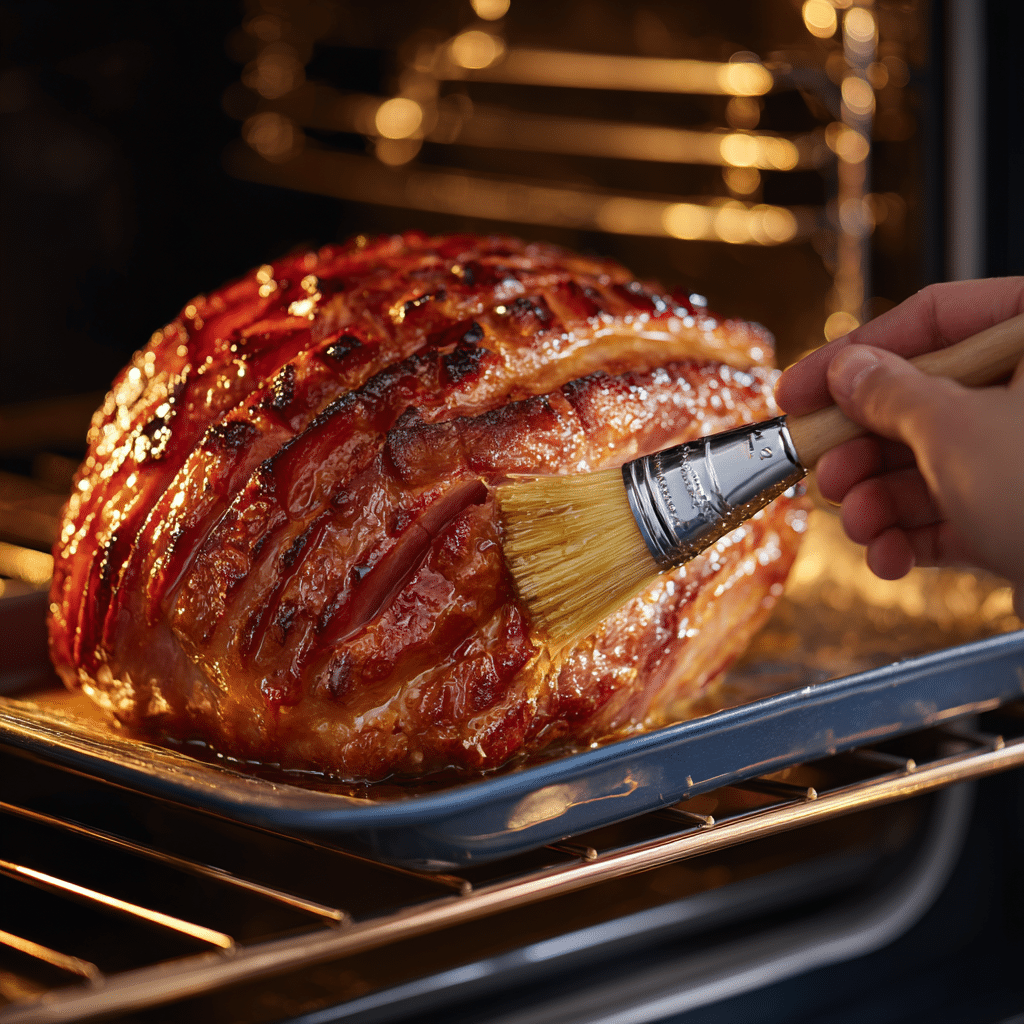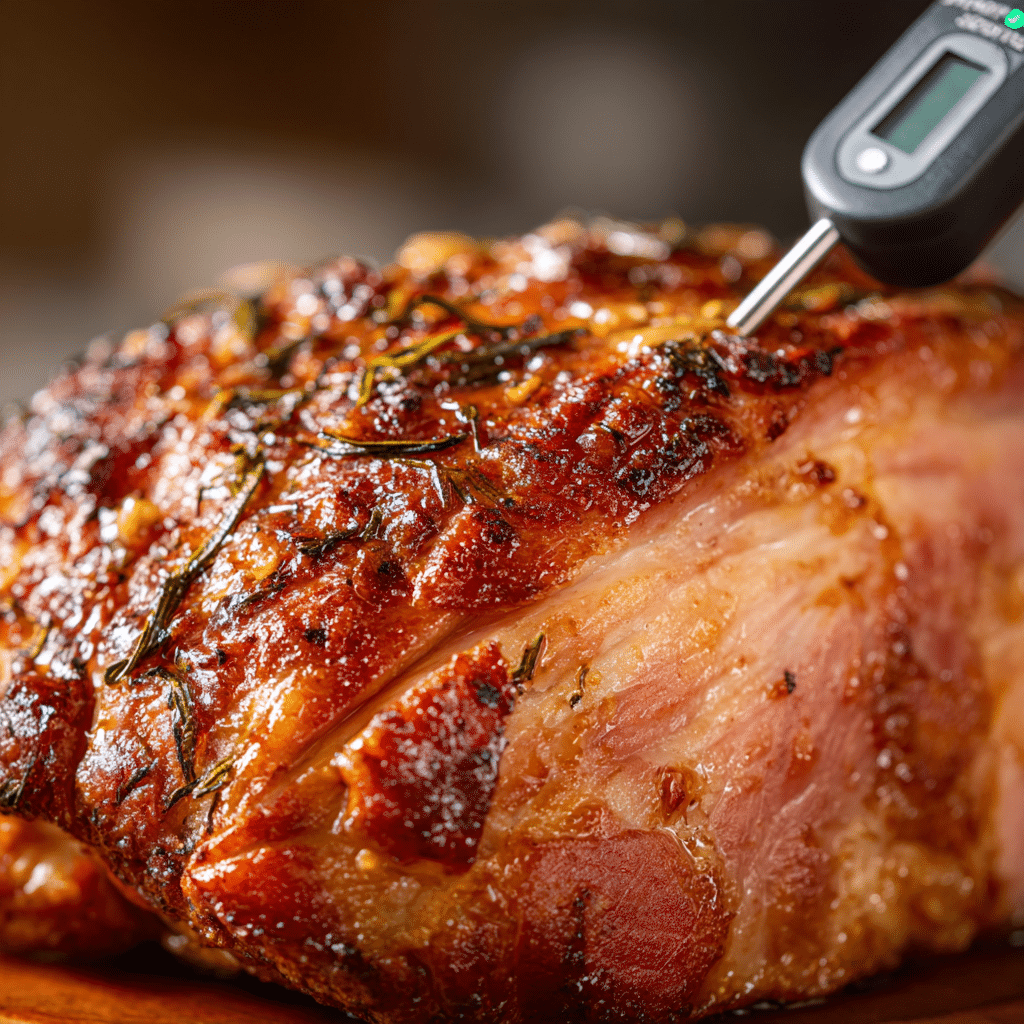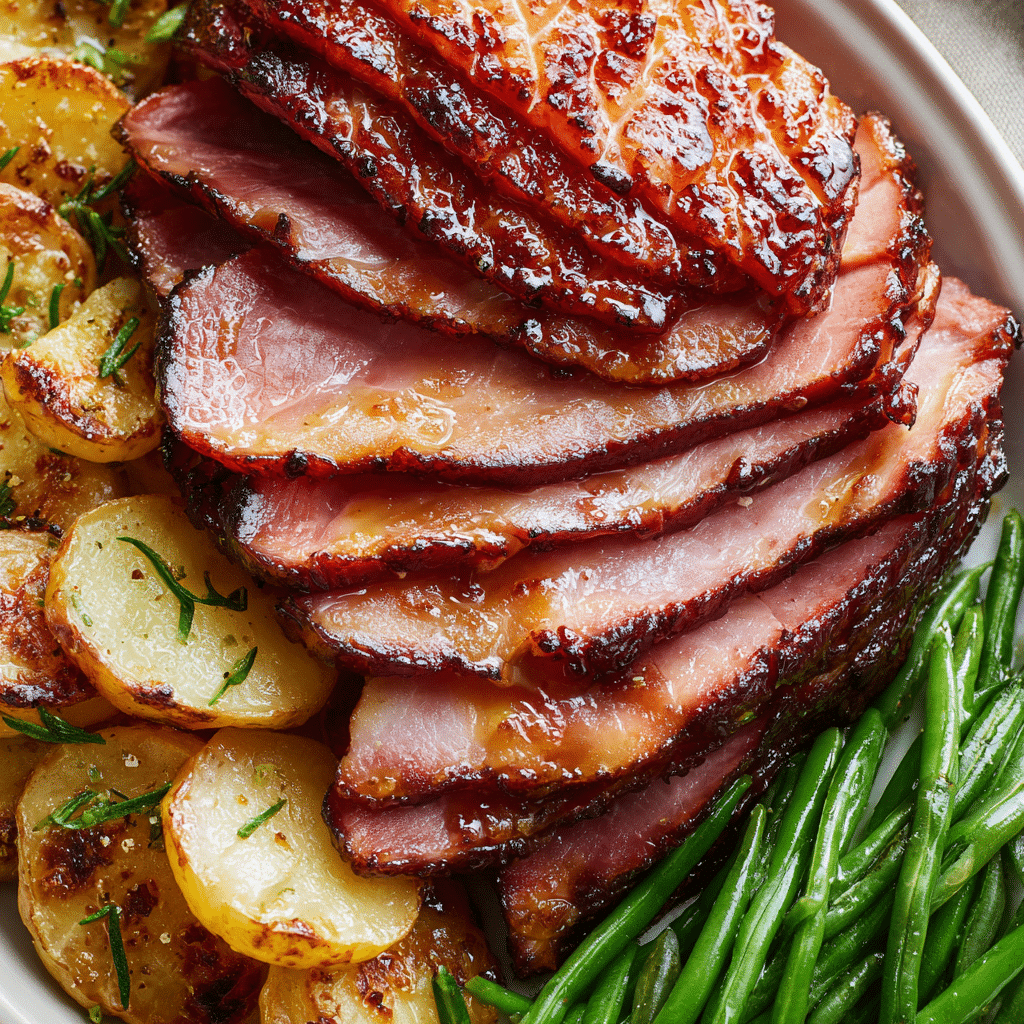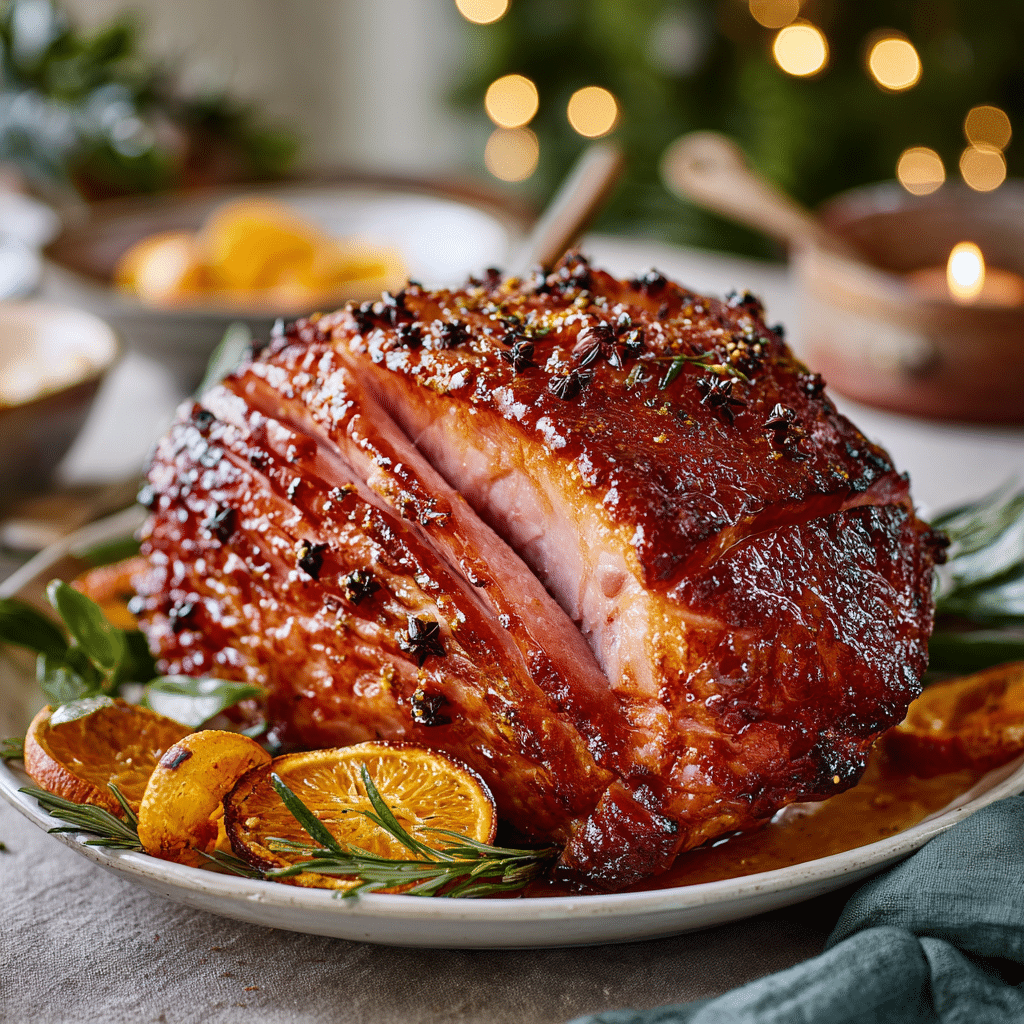Few dishes capture the spirit of the holidays like a beautifully baked honey glazed ham. With its golden crust, sweet-savory flavor, and irresistible aroma, this classic centerpiece has been a staple on festive tables for generations. Whether you’re preparing it for Christmas, Easter, or a family gathering, the key to success lies in the glaze especially when honey is the star ingredient. In this guide, we’ll walk you through everything from how to glaze ham with honey, when to apply it, cooking times, and preventing the glaze from burning, to creative serving ideas. By the end, you’ll be ready to present a ham that’s tender, juicy, and bursting with flavor.
Looking for more festive dishes? Discover our holiday main course recipes.
Why Honey Glazed Ham Is a Holiday Favorite
The History of Honey Glazed Ham
The tradition of glazed ham dates back centuries, when hams were cured and preserved for long winters. Over time, cooks began adding sweet glazes to balance the saltiness of the meat. Honey became a favorite choice thanks to its natural sweetness, availability, and ability to caramelize beautifully in the oven. By the mid-20th century, honey glazed ham had become a holiday staple in the United States, often served alongside turkey at Thanksgiving or as the star of a Christmas feast.
Why It’s Loved for Festive Meals
Honey glazed ham offers the perfect balance of flavors salty, sweet, and savory all at once. The honey caramelizes during baking, forming a glossy crust that enhances both taste and presentation. Beyond flavor, ham is also practical for large gatherings: it feeds a crowd, slices easily, and works beautifully in leftovers. Its versatility makes it just as welcome at Easter brunch as it is at a Christmas dinner table.
How to Glaze Ham with Honey

Classic Honey Glaze Ingredients
The foundation of a great honey glaze is simple, but it packs a lot of flavor. Most recipes combine:
- Honey – the star ingredient, for sweetness and caramelization.
- Brown sugar – deepens the sweetness and gives a rich color.
- Dijon or yellow mustard – balances sweetness with tang.
- Spices – such as cloves, cinnamon, nutmeg, or allspice for warmth.
- Citrus juice – orange or pineapple juice for brightness and acidity.
These ingredients work together to create a glaze that’s sweet, slightly tangy, and perfectly sticky.
Step-by-Step Glazing Method
- Prepare the ham: Score the surface of the ham in a crisscross diamond pattern. This not only looks attractive but also helps the glaze seep into the meat.
- Make the glaze: In a saucepan, combine honey, sugar, mustard, and citrus juice. Simmer until the mixture thickens slightly.
- Apply the first layer: Brush the glaze generously over the scored ham.
- Bake and reapply: Return the ham to the oven and continue to glaze every 20–30 minutes. Each layer builds flavor and creates a shiny caramelized crust.
- Finish with a final coat: Brush on a last coat just before serving for maximum shine and sweetness.
By layering the glaze during baking, you create that signature sweet-and-savory crust that makes honey glazed ham so irresistible.
Do You Put Glaze on Ham Before or After Cooking?
The Right Timing for Glaze Application
One of the most common questions about honey glazed ham is when to apply the glaze. The answer: both before and during the final stages of cooking. Applying a light glaze at the start helps flavor penetrate the ham as it warms, while additional layers later in the cooking process create a caramelized finish. If you add all the glaze at once, the sugars may burn before the ham is fully heated through.
Multiple Layers for a Caramelized Finish
The best results come from building the glaze in layers. After the ham has baked for some time and started to heat through, brush on the glaze every 20–30 minutes. Each layer thickens and caramelizes, creating that sticky, golden-brown coating that makes honey glazed ham so appealing. Save one generous coat for just before serving to give the ham a glossy, picture-perfect look.
By timing your glaze applications carefully, you ensure the meat absorbs flavor while the outside develops a sweet, shiny crust without burning.
What Gives Honey Glazed Ham Its Flavor?
The Role of Honey, Sugar, and Spices
The unique flavor of honey glazed ham comes from the sweet and savory balance created during roasting. Honey is the star it not only sweetens but also caramelizes, giving the ham its glossy finish. Brown sugar adds a deeper molasses note, while spices such as cloves, cinnamon, nutmeg, and allspice create a warm holiday aroma. Together, these ingredients transform the naturally salty ham into a flavorful masterpiece.
Pairing with Mustard, Cloves, or Citrus
Beyond honey and sugar, other key flavor boosters make honey glazed ham unforgettable:
- Mustard: Dijon or yellow mustard cuts through the sweetness with a tangy bite.
- Cloves: Traditionally, whole cloves are pressed into the scored ham, adding a festive look and aromatic spice.
- Citrus: Orange or pineapple juice brightens the glaze, balancing the richness of both the ham and honey.
This combination of sweet, salty, tangy, and spiced flavors is what gives honey glazed ham its signature taste—and why it has remained a holiday classic for generations.
How Long Does It Take for a Honey Glazed Ham to Cook?

General Cooking Time per Pound
Cooking time depends largely on the size of the ham and whether it’s pre-cooked or raw. Most store-bought holiday hams are fully cooked and only need reheating, which typically requires 10–12 minutes per pound at 325°F (163°C). For example, a 10-pound ham would need about 2 hours to heat through.
If you’re working with a fresh (uncooked) ham, allow about 20 minutes per pound at 325°F until it reaches a safe internal temperature.
Bone-In vs Boneless Ham Timing
- Bone-in ham tends to cook more slowly, but many cooks prefer it for its rich flavor and juiciness.
- Boneless ham heats more quickly and slices easily but may dry out if overcooked.
Regardless of type, always check doneness with a meat thermometer. The ham should reach an internal temperature of 140°F (60°C) for pre-cooked hams and 145°F (63°C) for raw hams before serving.
By timing it correctly and checking the internal temperature, you’ll ensure your honey glazed ham comes out tender, flavorful, and safe to enjoy.
How Do I Avoid Burning the Honey Glaze?
Adjusting Oven Temperature
One of the biggest challenges with honey glazed ham is preventing the sugars in the glaze from burning. The trick is to cook low and slow. Keep the oven set to 325°F (163°C) for most of the cooking time. If you notice the glaze starting to darken too quickly, reduce the oven temperature slightly. The goal is to let the glaze caramelize gently without crossing into bitterness.
Using Foil and Glaze Layering Techniques
Covering the ham loosely with aluminum foil can protect the glaze from burning while still allowing the ham to heat through. Remove the foil during the last 20–30 minutes so the glaze can set and develop its glossy finish.
Another tip is to apply the glaze in layers, rather than all at once. Start glazing in the final hour of cooking, brushing every 20 minutes. This prevents the sugars from spending too long under direct heat while still giving you that classic sticky crust.
By managing heat carefully and layering the glaze, you’ll achieve a ham that’s golden, glossy, and perfectly sweet without the bitterness of burnt sugar.
Is 3 Hours Long Enough to Cook a Ham?
Size and Weight Considerations
Whether three hours is enough depends on the size and type of ham. A fully cooked ham weighing around 12–14 pounds usually takes close to 3 hours at 325°F (163°C) to heat through. Smaller hams will be ready sooner, while larger ones may need additional time.
For a fresh (raw) ham, three hours is often not enough unless the ham is very small (under 10 pounds). Raw hams generally require closer to 20 minutes per pound, which can extend cooking time significantly.
Internal Temperature and Doneness Check
Instead of relying solely on time, always check doneness with a meat thermometer. The USDA recommends:
- 140°F (60°C) for reheating a pre-cooked ham.
- 145°F (63°C) for a raw ham, followed by a rest period of 3 minutes.
If your ham hasn’t reached these temperatures after 3 hours, keep cooking until it does. Remember every oven is different, and weight matters.
In short, 3 hours may be enough for a medium fully cooked ham, but always verify with a thermometer for safety and the juiciest results.
Step-by-Step Honey Glazed Ham Recipe
Ingredients List & Preparation
Here’s a classic recipe for a honey glazed ham that works beautifully for Christmas, Easter, or any holiday gathering:
| Ingredient | Amount | Notes |
|---|---|---|
| Fully cooked bone-in ham | 8–10 lbs | Spiral-cut preferred for easy slicing |
| Honey | 1 cup | Main sweetener for glaze |
| Brown sugar | ½ cup | Adds caramel depth |
| Dijon mustard | 2 tbsp | Balances sweetness |
| Orange juice | ½ cup | Bright, citrusy flavor |
| Whole cloves | As needed | Optional, for studding ham |
| Ground cinnamon | ½ tsp | Warm spice for glaze |
| Ground nutmeg | ¼ tsp | Adds festive aroma |
Preparation:
- Preheat oven to 325°F (163°C).
- Score the ham in a crisscross diamond pattern. Insert cloves into the intersections for a classic holiday look.
- Place ham in a roasting pan lined with foil.
Baking, Glazing, and Serving
- In a saucepan, combine honey, brown sugar, mustard, orange juice, cinnamon, and nutmeg. Simmer until slightly thickened.
- Brush ham with a thin layer of glaze. Cover loosely with foil and bake.
- During the final hour of cooking, brush glaze over the ham every 20 minutes.
- Remove foil for the last 20–30 minutes so the glaze caramelizes into a glossy finish.
- Allow ham to rest 10–15 minutes before slicing.
This step-by-step process creates a sweet, sticky, golden crust while keeping the meat tender and flavorful.
Serving Suggestions & Leftover Ideas

Side Dishes That Pair Well with Honey Glazed Ham
Honey glazed ham is versatile and pairs wonderfully with both sweet and savory sides. Some festive favorites include:
- Scalloped potatoes or mashed potatoes – creamy and hearty to balance the ham’s sweetness.
- Green bean casserole or roasted Brussels sprouts – adds freshness and crunch.
- Mac and cheese – rich, cheesy comfort food that pairs perfectly.
- Cornbread or dinner rolls – great for soaking up the glaze.
- Fruit chutney or cranberry sauce – a tangy complement to the salty-sweet ham.
Creative Uses for Leftovers
One of the best things about making a large honey glazed ham is the leftovers. Instead of reheating slices, try these creative ideas:
- Ham sandwiches with mustard or honey butter.
- Ham and cheese quiche for a quick breakfast.
- Split pea soup with ham made from the bone.
- Ham fried rice or pasta for an easy weeknight dinner.
- Ham salad spread for sandwiches or crackers.
Leftover honey glazed ham not only stretches your holiday feast but also transforms into a variety of dishes that keep the flavor going all week long.
FAQs About Honey Glazed Ham
How to glaze ham with honey?
To glaze ham with honey, make a mixture of honey, brown sugar, mustard, and citrus juice. Brush it over the ham during the final hour of baking, reapplying every 20 minutes for a shiny, caramelized finish.
Do you put glaze on ham before or after cooking?
Apply a thin layer before baking to start flavoring the ham, then continue glazing during the last 45–60 minutes. This layering builds flavor while preventing the sugars from burning.
What gives honey glazed ham its flavor?
The flavor comes from the balance of salty ham with sweet honey, brown sugar, and warm spices like cloves and cinnamon. Citrus juice and mustard add tangy notes that round out the glaze.
How long does it take for a honey glazed ham to cook?
Most fully cooked hams require 10–12 minutes per pound at 325°F (163°C). A 10-pound ham will take about 2 hours. Always check with a meat thermometer to confirm doneness.
How do I avoid burning the honey glaze?
Cook at a moderate oven temperature, cover the ham loosely with foil, and start glazing only in the last hour of cooking. Apply glaze in thin layers instead of all at once.
Is 3 hours long enough to cook a ham?
For a medium fully cooked ham (12–14 lbs), 3 hours is usually enough. For larger hams or raw hams, you may need longer. The ham is ready when it reaches an internal temperature of 140°F for cooked hams or 145°F for raw hams.
Conclusion
Honey glazed ham is more than just a holiday dish it’s a tradition that combines sweet, salty, and savory flavors in one stunning centerpiece. By glazing in layers, cooking at the right temperature, and pairing it with festive sides, you can serve a ham that’s tender, flavorful, and picture-perfect. Don’t forget the leftovers: from sandwiches to soups, honey glazed ham keeps the holiday spirit alive well beyond the feast.
Looking for more holiday inspiration? Try our Christmas dinner recipes or discover tasty leftover ham ideas.

Classic Honey Glazed Ham
Ingredients
Equipment
Method
- Preheat oven to 325°F (163°C). Line a roasting pan with foil.
- Score the ham in a diamond pattern and insert whole cloves into the intersections if using.
- In a saucepan, combine honey, brown sugar, mustard, orange juice, cinnamon, and nutmeg. Simmer until slightly thickened.
- Brush the ham with a thin layer of glaze, cover loosely with foil, and place in the oven.
- Bake for 10–12 minutes per pound, brushing glaze over the ham every 20 minutes during the final hour.
- Remove foil for the last 20–30 minutes to allow the glaze to caramelize into a glossy finish.
- Allow ham to rest 10–15 minutes before slicing and serving.
